
What Are AI Tools? | Wondershare Virbo Glossary

What Are AI Tools? | Wondershare Virbo Glossary
Part 1. What are AI tools?
AI tools, also known as artificial intelligence tools, refer to software applications or systems that utilize artificial intelligence techniques to automate tasks, solve complex problems, or enhance human capabilities in various domains. AI tools leverage the capabilities of machine learning, language processing, computer vision, and other AI techniques to analyze data, make predictions, generate valuable insights, and accomplish tasks that were traditionally dependent on human intelligence.
AI tools encompass a broad range of software applications and systems that harness artificial intelligence techniques to automate tasks, solve complex problems, and augment human capabilities. From machine learning platforms to natural language processing tools, computer vision systems, chatbot development platforms, recommender systems, and data analytics tools, these AI tools are revolutionizing industries and transforming how we work. By leveraging the power of AI, organizations, and individuals can gain valuable insights, improve efficiency, and create innovative solutions across various domains.
Part 2. The underlying factors contributing to the rise of AI tools
The emergence of AI tools is a result of several factors coming together. Here are some background factors:
01of 05Growing data volume
The digital age and widespread adoption of the internet have led to the generation and storage of vast amounts of data. The scale and complexity of this data have increased rapidly, making traditional data processing methods inadequate. AI tools can handle large-scale data and extract useful information from it, making them a solution to meet this demand.
02of 05Advancements in hardware and computing power
With the continuous improvement of computer hardware and processing capabilities, such as graphics processing units (GPUs) and cloud computing technologies, AI tools can perform complex computations faster and more accurately. This provides a robust infrastructure for the development and utilization of AI tools.
03of 05Progress in algorithms and models
Algorithms and models in the field of AI have been continuously evolving and improving. For example, the rise of deep learning models enables computers to better process complex data types such as images, speech, and natural language. These advancements enable AI tools to handle and analyze data with greater accuracy and efficiency.
04of 05Business needs and competitive pressures
Businesses face increasingly fierce competition and ever-changing market demands. AI tools offer an innovative and intelligent way to address these challenges. By leveraging AI tools, organizations can optimize their operations, improve products and services, and enhance their competitiveness.
05of 05Drive from scientific research
The investment in AI technology by academia and research institutions has been a driving force behind the development of AI tools. The efforts and innovations of researchers have propelled advancements in algorithms and models, providing a theoretical and practical foundation for the development of AI tools.
In conclusion, the emergence of AI tools is the result of multiple factors interacting, including the growth of data, advancements in hardware and computing power, progress in algorithms and models, as well as business needs, and the drive from scientific research. These background factors collectively contribute to the development and application of AI tools.
Part 3. How to treat AI tools?
Our attitude towards AI tools can vary because they can be influenced by various factors, including cultural differences, societal demands, ethical considerations, responsible usage, and understanding of their limitations. The key is to strike a balance between embracing the potential benefits of AI tools while also addressing the ethical considerations and potential challenges they may present.
Part 1. What are AI tools?
AI tools, also known as artificial intelligence tools, refer to software applications or systems that utilize artificial intelligence techniques to automate tasks, solve complex problems, or enhance human capabilities in various domains. AI tools leverage the capabilities of machine learning, language processing, computer vision, and other AI techniques to analyze data, make predictions, generate valuable insights, and accomplish tasks that were traditionally dependent on human intelligence.
AI tools encompass a broad range of software applications and systems that harness artificial intelligence techniques to automate tasks, solve complex problems, and augment human capabilities. From machine learning platforms to natural language processing tools, computer vision systems, chatbot development platforms, recommender systems, and data analytics tools, these AI tools are revolutionizing industries and transforming how we work. By leveraging the power of AI, organizations, and individuals can gain valuable insights, improve efficiency, and create innovative solutions across various domains.
Part 2. The underlying factors contributing to the rise of AI tools
The emergence of AI tools is a result of several factors coming together. Here are some background factors:
01of 05Growing data volume
The digital age and widespread adoption of the internet have led to the generation and storage of vast amounts of data. The scale and complexity of this data have increased rapidly, making traditional data processing methods inadequate. AI tools can handle large-scale data and extract useful information from it, making them a solution to meet this demand.
02of 05Advancements in hardware and computing power
With the continuous improvement of computer hardware and processing capabilities, such as graphics processing units (GPUs) and cloud computing technologies, AI tools can perform complex computations faster and more accurately. This provides a robust infrastructure for the development and utilization of AI tools.
03of 05Progress in algorithms and models
Algorithms and models in the field of AI have been continuously evolving and improving. For example, the rise of deep learning models enables computers to better process complex data types such as images, speech, and natural language. These advancements enable AI tools to handle and analyze data with greater accuracy and efficiency.
04of 05Business needs and competitive pressures
Businesses face increasingly fierce competition and ever-changing market demands. AI tools offer an innovative and intelligent way to address these challenges. By leveraging AI tools, organizations can optimize their operations, improve products and services, and enhance their competitiveness.
05of 05Drive from scientific research
The investment in AI technology by academia and research institutions has been a driving force behind the development of AI tools. The efforts and innovations of researchers have propelled advancements in algorithms and models, providing a theoretical and practical foundation for the development of AI tools.
In conclusion, the emergence of AI tools is the result of multiple factors interacting, including the growth of data, advancements in hardware and computing power, progress in algorithms and models, as well as business needs, and the drive from scientific research. These background factors collectively contribute to the development and application of AI tools.
Part 3. How to treat AI tools?
Our attitude towards AI tools can vary because they can be influenced by various factors, including cultural differences, societal demands, ethical considerations, responsible usage, and understanding of their limitations. The key is to strike a balance between embracing the potential benefits of AI tools while also addressing the ethical considerations and potential challenges they may present.
Reaching a Wider Audience Using Video Translation in Tamil
Expanding your video content into Tamil opens doors to a vast audience. With over 75 million Tamil speakers worldwide, tapping into this demographic can amplify your reach.Video translation in Tamil not only breaks language barriers. It also fosters cultural connections with your target audience.
By reaching Tamil-speaking viewers, you unlock new avenues for brand exposure. You also increase your chances of community engagement. The next parts will teach you how totranslate English to Tamil language . The page will also introduce an AI-powered app to help you connect with this vibrant audience. Explore the article to learn more.

Part 1. Notice to Readers: Difference of Translating or Transcribing in Tamil
Translating and transcribing are two distinct processes. Each is crucial in its own right when it comes toTamil language translate to English :
Meaning
Translating is converting the meaning of spoken words or written text from one language to another, like English convert to Tamil meaning. It ensures that the essence and intent remain intact. Transcribing focuses on converting spoken words into written text. It captures the dialogue or narration without considering the nuances of translation.
Context
Translation takes into account the broader context of the content. It often factors in cultural references and idiomatic expressions. It also takes into account societal norms to convey the message. Transcription deals with capturing the spoken words. It doesn’t delve into the context or cultural nuances.
Nuances
Translation requires knowing both languages involved. It allows you to convey the nuances of the original content. Transcription focuses more on capturing the spoken words. It often doesn’t consider the linguistic nuances or cultural context.
Automatic translation tools like YouTube can do video translation in Tamil. But, they often struggle to capture the nuances of translating and transcribing. AI-powered apps like Wondershare Virbo offer a solution by combining translation and transcription.
Part 2. How To Translate Videos in Tamil and Vice-Versa
Translating videos has never been easier, thanks to manyTamil to English converter app or software, such as Virbo. It’s a versatile tool powered by advanced AI technology. If you’re looking to connect with Tamil-speaking communities, Virbo streamlines the translation process. The app saves you time and effort so you can focus on creating wonderful content. Follow the steps below to start video translation in Tamil and vice versa:
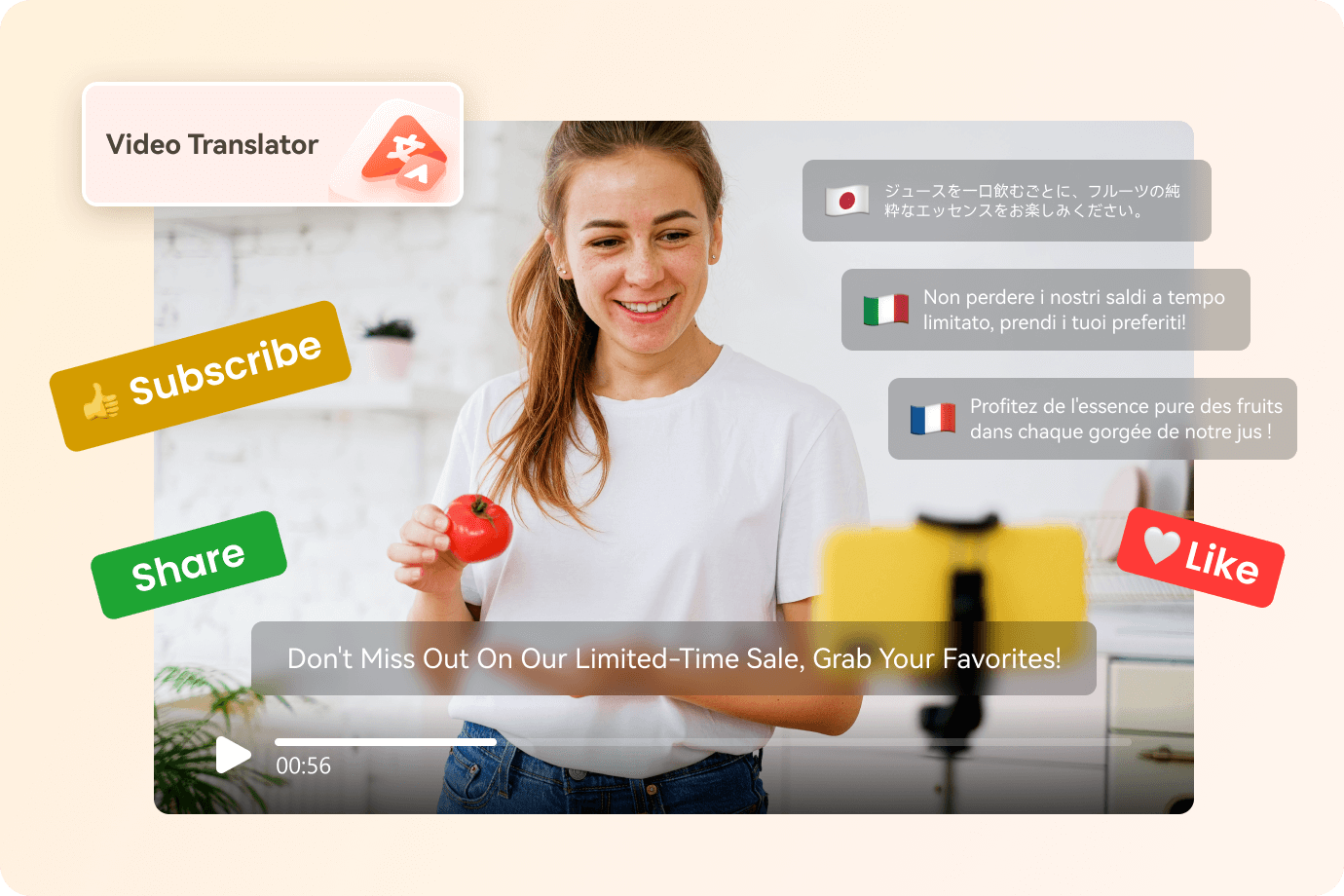
- Step 1: Download and install Virbo on your computer. Log in using your Email, Wondershare, Google, Facebook, or Twitter account. If downloading is not possible, you can use the Virbo online tool . To start translating, click on theVideo Translator button.
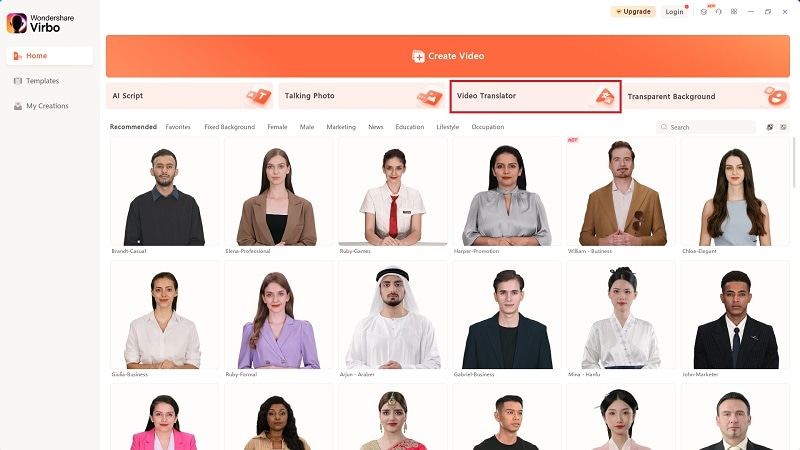
Get Started Online Free Download
- Step 2: Upload the video for translation. Next, set up your preferred language settings. Change the source and target languages on the right side (Tamil in this case). Add subtitles and lip-sync based on your preference.
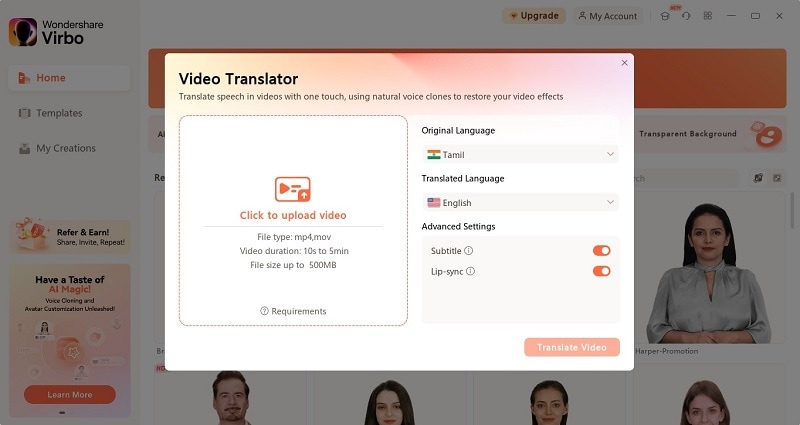
- Step 3: Preview the multilingual video to ensure accuracy once the translation process is complete. Make any necessary adjustments if needed. Finally, download or export the translated video in your desired format.

Key Features of Virbo
Virbo’s AI technology offers a range of features to enhance your translation experience:
- AI video translations. Virbo supports over 20 languages, including Tamil, ensuring accurate and efficient translations.
- AI avatars. Customize your video with AI avatars to add a personal touch to your content.
- AI voice. Choose from a variety of AI voices. Match the tone and style of your video.
- AI Script. Generate transcripts and captions using Virbo’s AI script feature.
Use Cases of Virbo
Here are many scenarios where you can take advantage of Virbo:

Build stronger customer loyalty
Engage Tamil-speaking customers by translating product tutorials and testimonials. You can also provide customer support videos in Tamil. It fosters stronger relationships and loyalty for your brand’s success.
Stand out in social media
Capture the attention of Tamil audiences on social media platforms. Translate and localize your video content to increase engagement and shares.
Boost digital marketing
Expand your reach and drive conversions by translating marketing videos and advertisements. Translate your promotional content into Tamil to tap into a new market segment.
Pricing
Virbo offers flexible pricing options for users interested in video translation in Tamil. While there’s a free version available, the paid plan offers features suited for your Tamil content (as of March 6, 2024):
- Monthly Plan. $9.9/month - The plan grants you access to 10 minutes of video credits every month. It’s ideal for occasional video translations.
- Yearly Plan – Essential . $19.9/year - This plan gives you 22 minutes of video credits annually. It caters to moderate translation needs for Tamil videos.
- Yearly Plan – Pro . $199/year – The pro plan is for heavy users and businesses looking to translate a significant volume of Tamil videos. It offers a generous 300 minutes of video credits per year.
Additionally, the Monthly Plan supports videos of up to 2 minutes long. Meanwhile, both Yearly Plans allow for videos of up to 5 minutes. Regardless of your plan, they all have a maximum resolution of 1080p and unlimited time for AI scripts.
Part 3. Other Methods to Translate in Tamil
There are alternative methods available if you prefer different English to Tamil translate approaches. Yet, it’s important to note that these methods cater to text translation. They may not capture the nuances and context of video content. Let’s explore two common alternatives:
Google Translate
Google Translate is a well-known tool for translating text from one language to another, such asEnglish to Tamil translation . Here’s how you can use it for basic translation:
- Step 1 : Visit the Google Translate website or open the Google Translate app. Select the input and output languages (e.g., English to Tamil).
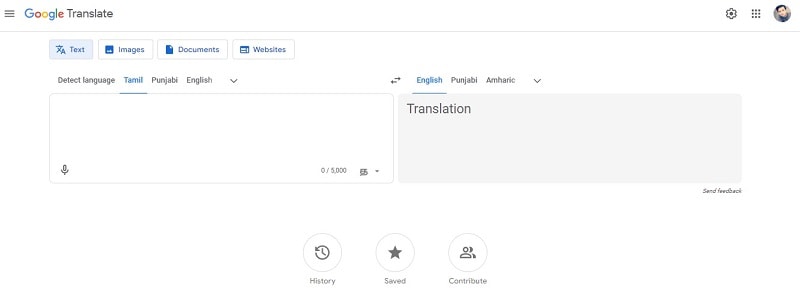
- Step 2 : Type or paste the text you want to translate into the provided box. Google Translate will instantly translate the text into Tamil.
Remember that Google Translate may not always produce the most accurate translations. It’s especially evident for complex sentences or specialized terminology.
YouTube Video Translation
YouTube offers a built-in feature for translating video titles and descriptions. It can also generate subtitles in many languages, including languages from English to Tamil. Here’s how you can use it:
- Step 1 : Upload your video to YouTube and navigate to the video’s editing page. Click theSubtitles/CC tab.
- Step 2 : Select the language you want to translate your subtitles into (e.g., Tamil). YouTube will automatically generate machine-translated subtitles.
- Step 3 : Review and edit the translated subtitles to ensure accuracy and coherence.
YouTube’s video translation in Tamil feature can be helpful at times. But, it may not capture the nuances or cultural context accurately. Manual editing is often required to refine the translations. This is important to ensure they align with the original video content.
Conclusion
Reaching Tamil-speaking audiences through video translation is essential for expanding reach and engagement. While alternatives like Google Translate and YouTube exist, they may lack accuracy and nuance. Wondershare Virbo stands out with its AI-powered features. The app ensures precise and efficient English translation to Tamil language or any other languages in video translation.
Using these strategies empowers content creators to connect with Tamil audiences. It can drive meaningful engagement and growth. Elevate your content’s impact using tools like Virbo for seamlessvideo translation in Tamil . Embrace the opportunity to make an impact with diverse audiences. Amplify your message and win the Tamil-speaking audience with your powerful content creation.
Easy Ways to Translate TikTok Videos
TikTok has become a global sensation in today’s digital age. Their short-form video content has transformed the social media landscape. It has become one of the most popular social media platforms, with millions of users worldwide.
To maximize engagement reach, creators can nowtranslate TikTok videos into different languages and expand their audience. If you are curious, we’ll delve into how to translate TikTok videos in this article.

Part 1. Why Do Creators and Brands Need to Translate TikTok Videos
TikTok’s translation feature helps users understand content in different languages. It translates captions and text from one language to another. Hence, everyone can enjoy the videos. To use the translation feature, tap “See translation” at the bottom of the screen. The app will translate the captions into your device’s language.
Here are more reasons why it’s important:
Reaching New Markets
TikTok translate breaks language barriers. Helping you reach new audiences who may not understand your content otherwise. This feature makes it easier to connect with them. And leading to more engagement and potential leads.
Enhancing Rankings
Translating content broadens its reach, leading to increased engagement and popularity. This feature, in turn, can improve its ranking on search engines. Higher rankings mean more visibility and traffic. This means more conversions, especially if the video is embedded on your website.
Improving TikTok Advertising
When running ads, the translation tool allows targeting audiences in other languages. This feature eliminates language barriers and expands your ad reach. Potential increasing ad effectiveness and reaching a wider audience.
Boosting Sales Conversions
Adding captions to videos increases impressions by over 55%. As a business owner, captions help. With the translation tool, more people from different backgrounds can understand your content. This feature will enhance the viewing experience. Potential in boosting their chances of buying your product.
Part 2. How to Translate TikTok Videos to English with Auto-Translate Feature
In 2022, TikTok introduced translation tools to break down language barriers. Making content more accessible to all users. The main components of TikTok’s translation tool include captions and description translation, auto-generated video captions, and sticker translation.
1. Captions and description translation
This feature allows users to auto-translate captions and descriptions. Therefore, users can enjoy TikTok videos in languages other than their own. For instance, if you want totranslate a TikTok video to English from Japanese captions. You can follow these steps:
- Step 1. Go to your profile, then click the three strips at the top of the screen.

- Step 2. Open Settings and Privacy

- Step 3. Go to Language under the Content & Activity section

- Step 4. Toggle on Always Show Translations

Once selected, you can translate captions and descriptions of videos in different languages. You can click “See Translation” when watching TikTok’s videos.
2. Auto-generated video captions
This feature allows viewers to enable closed captions for videos they’re watching. And eliminate the need for creators to add captions manually. The auto-generated captions appear above the video creator’s name on the For You Page. Captions will appear once you tap them.

3. Sticker Translation
This feature enables the translation of text stickers. Stickers are the text overlays you see while watching a video. With this feature, you can understand the text stickers that are using other languages.
These translation features facilitate communication across language barriers. Accessing content from around the world becomes easier. Regardless of one’s language or geographical location. You can go to this link for more detailed information about auto-translate tools.
Part 3. How to Translate TikTok Videos into Any Language with AI Video Translator
TikTok’s auto-translation feature has a limited range of languages. They only allow auto-translation within captions. Wondershare Virbo offers a solution to enhance your experience beyond the platform’s features.TikTok video translator by W onder share Virbo is a tool that enables users to make their TikTok videos speak in different languages. By using this tool, you can also add subtitles to the videos.
Here is the step-by-step guide how to translate TikTok video using Virbo’s AI Video Translator tool:
- Step 1. Go to Wondershare Virbo official website and select Generate AI Video Online.

Get Started Online Free Download
- Step 2. Create an account or log-in

- Step 3. Once you land on the Virbo homepage, go to Video Translate

- Step 4. Upload the video you want to translate
In the Video Translator interface, upload the video file you want to translate. Then, select the original video language and the preferred target language. You can also activate the Lip Sync feature to ensure the accuracy of audio translation with the video’s lip movements.

- Step 5. Click “Translate this video” to start the translation process. Virbo AI will seamlessly translate the audio and synchronize it with the video. Depending on the video’s length and complexity, the process may take some time to complete.
Conclusion
In conclusion, using Virbo’s Translator tool totranslate TikTok videos has many benefits. It helps creators reach more people and engage with diverse audiences worldwide. As we look to the future of making content on TikTok, tools like Virbo’s Translator tool will be super necessary. They’ll help break down language barriers and make content accessible to everyone.
How To Generate Speech From Text | The Top Text-to-Speech Converters
In today’s digital age, using the latest technology to enhance productivity is imperative. Text-to-speech converters have revolutionized the way we interact with written content. Knowinghow to generate speech from text serves a great number of benefits. This cutting-edge technology has allowed humankind to bridge the gap between language and technology.
Here, you can delve deep into the world of text-to-speech converters. Discover the top features, benefits, and how-to guides toconvert text to voice easily.
Part 1: What are the Benefits of Converting Text to Audio in Real Life?
It would be a good idea toconvert text into audio for several reasons. Here are some key benefits that the process can provide:
1. Accessibility and Assistance
Text-to-audio conversion plays a crucial role in creating a more inclusive digital environment. People with various forms of disabilities and impairments can make use of this technology. Converting text into audio empowers such individuals and helps them stay informed and connected to the real world.
Reading content, particularly long-form content, can be challenging for people with visual impairments, dyslexia, or other reading and developmental difficulties. If youconvert text to audio , you can make your written content easily accessible to them.
2. Enhanced Learning and Language Improvement
Converting text to speech can significantly benefit language learners. Studies have proved that listening to text aloud helps greatly improve pronunciation, comprehension, and fluency. To enhance their language, a simple solution is toturn text into audio and listen to it. Many converters have various speech options these days that can help with this.
3. Ease of Content Consumption
An added benefit ofgenerating speech from text is making your content easy to access and consume. Users have different preferences for content consumption. Written content is often a cause of eye strain and fatigue. Engaging audio content provides a great alternative to written content. By simple conversion, your content can cater to different user learning styles.
4. Improved Engagement
Audio content can be much more engaging as compared to written content. Bycreating voice from text , you can capture the audience’s attention and create a more immersive experience. Text-to-speech conversions can also facilitate better communication. It enables natural and engaging interactions between users and their devices.
5. Boosting Productivity
Moreover,converting text to voice is a good idea when you wish to boost efficiency. Especially in professional settings, you can listen to important documents, emails, or reports on the go. You can perform other tasks simultaneously, enabling you to save time. This can add a significant productivity boost to your everyday tasks.
Part 2: The Best Tools Available in the Market to Generate Audio from Text
After knowing the benefits of text-to-speech conversion, you might wonder how to perform the task. Here are the top 5 tools that can help youcreate audio from text quickly and easily.
1. Virbo
Topping our list of the best tools toconvert text to voice is Virbo. Powered by Wondershare, Virbo is based on state-of-the-art AI technology. The tool provides an interactive interface and easy-to-use functions. You can easily convert any text into a range of voices using this.
Virbo offers a wide range of voices for users to choose from. It is the perfect cross-platform tool to easily generate high-quality content on both Windows and Apple devices. With many voices, tones, and languages to choose from, it is just what you need for quick text-to-voice conversions.
Key Features
- Virbo offers many realistic avatars, languages, and accents to make your content unique and cater to every need.
- You can customize various aspects of your AI avatar, including gender, attire, and tone, with ease.
- Besides a wide range of voices, Virbo also offers an AI script generator. You can thus create efficient scripts for multiple purposes.
Steps to Use Wondershare Virbo For Generating Speech From Text
Virbo makes it fairly easy toconvert text into audio . Here are the detailed steps on how to generate speech from text using Virbo:
Step 1: Launch Virbo and Select your Feature
To start, install and launch Wondershare Virbo on your device. Select the “Text to Speech” option from the program’s main interface. Now, select a template of your choice. Among the listed options, you can choose a language and tone. Virbo offers more than 150 options to choose from, and click on the “Convert Now” button.
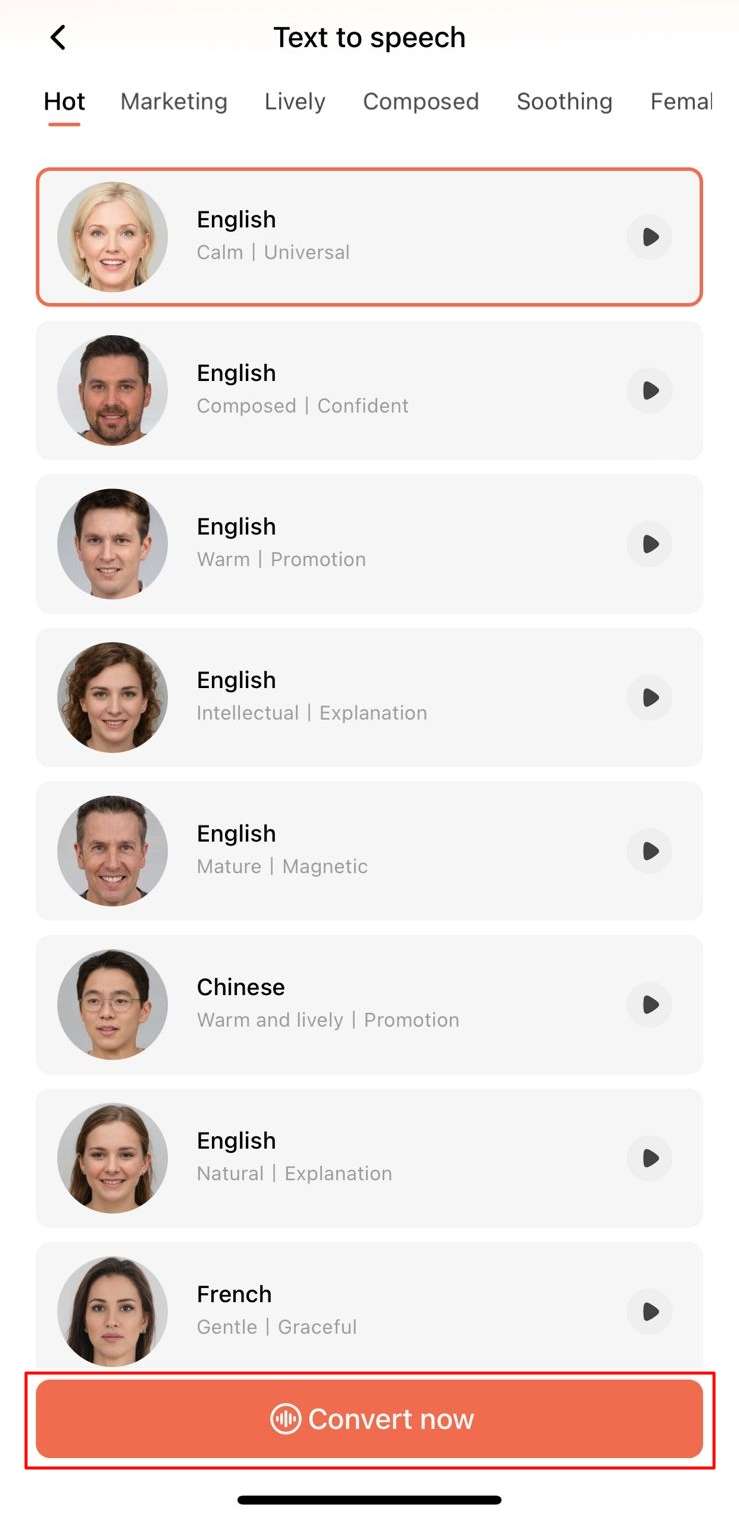
Get Started Online Free Download
Step 2: Input the Desired Text
In the next interface, you can add your desired text to convert into speech. Click the “Create Video” button, choose the video orientation, and Virbo will automatically convert your text into speech. You can edit your generated video further and tweak the features as you like.
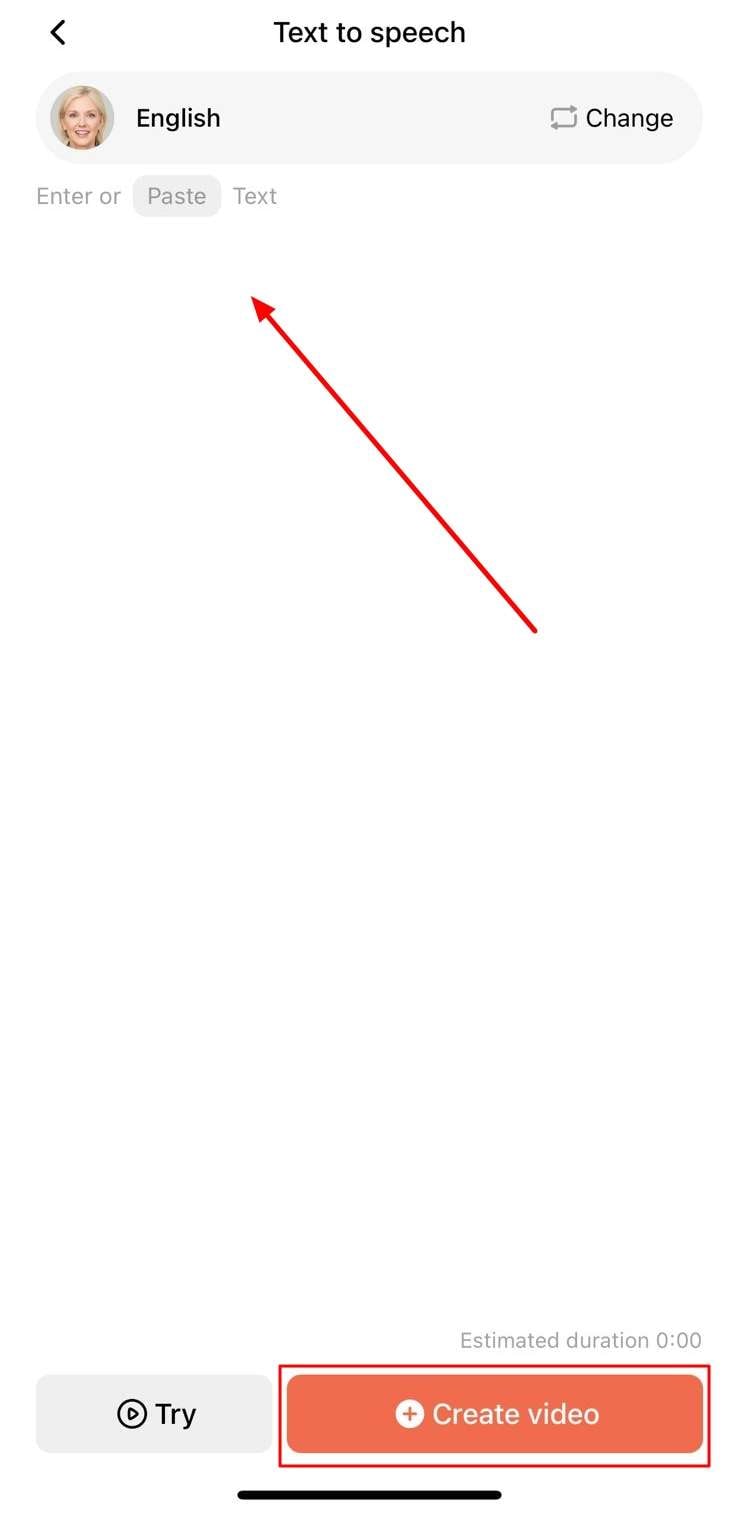
Step 3: Preview and Export the AI Video
Once you have worked through the entire editing, preview the video. Then, select the “Export” button to save the video on your smartphone.
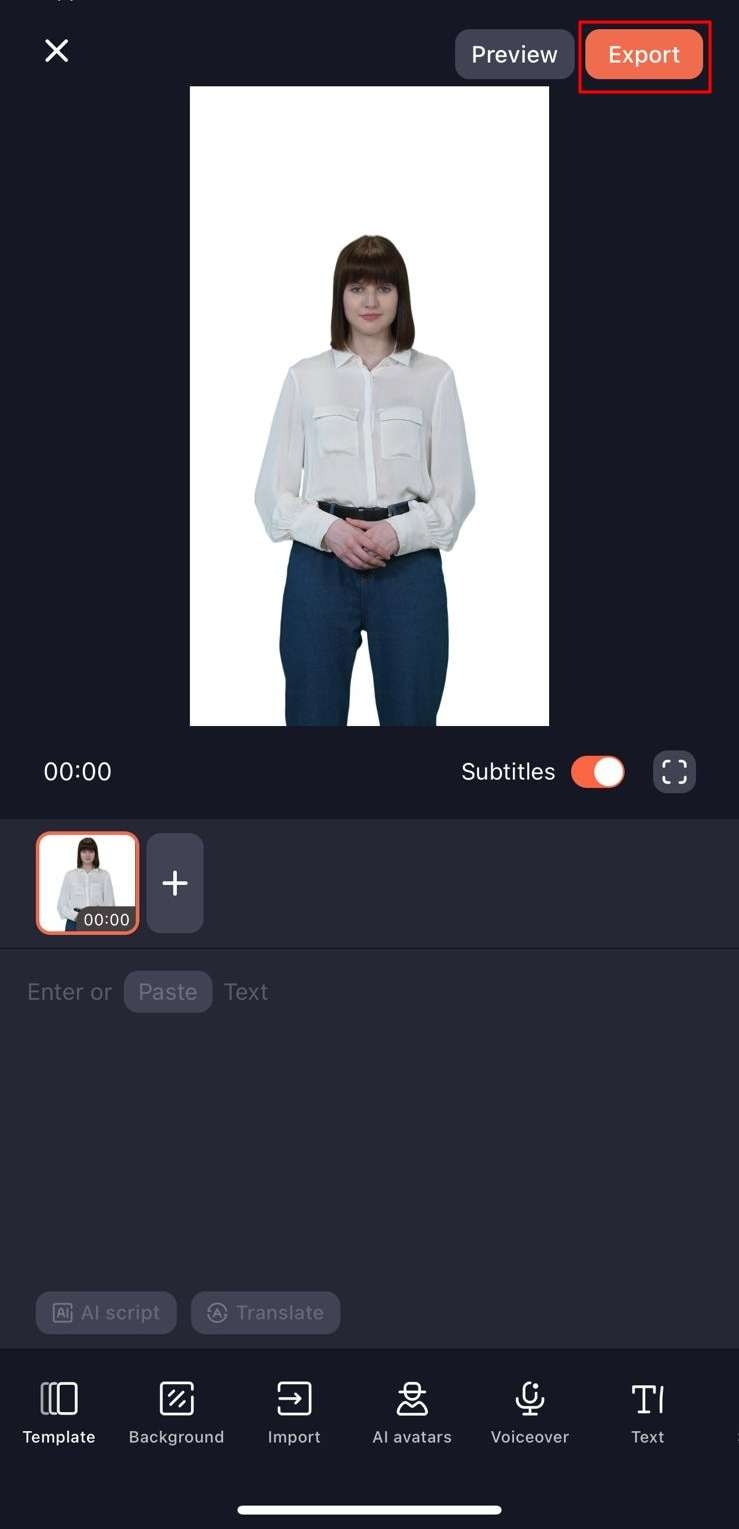
2. Murf.ai
If you are looking for an online tool toconvert text to audio , Murf.ai is a good choice. This versatile web-based tool enables users to generate high-quality speech. The AI algorithm of Murf.ai can easily generate life-like, natural voices.
Besides text-to-speech conversions, Murf.ai also offers several other useful elements. The feature-packed tool offers several unique voices to suit varying moods. You can use the generated audio for podcasts, videos, and other instances.
Key Features
- ai lets users save the output in multiple file formats and quality types.
- Besides text-to-voice, you can also add other media elements like images and videos to your final output.
- ai also enables users to collaborate with their teams and add a shared workspace to boost productivity.
Steps To Use Murf.ai For Generating Speech From Text
Step 1: Go to Murf.ai and click the “Open Studio” button. You will be redirected to the studio workspace, where you can click “Create Project.” From the next tab, choose the option most suited to your project from the available list and tap the “Create Project” button.
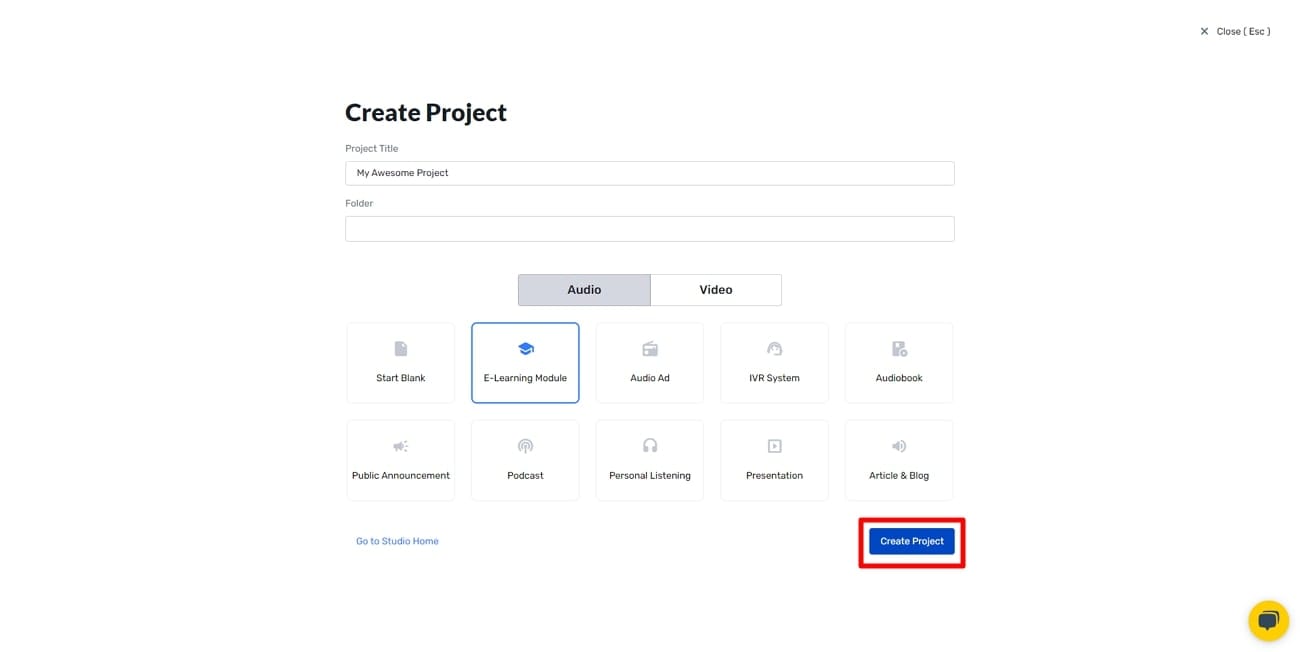
Step 2: You can now type the text you want to convert into speech. From the panel at the top, you can select the language and voice of the audio. You can also modify other aspects, such as the pitch and speed.
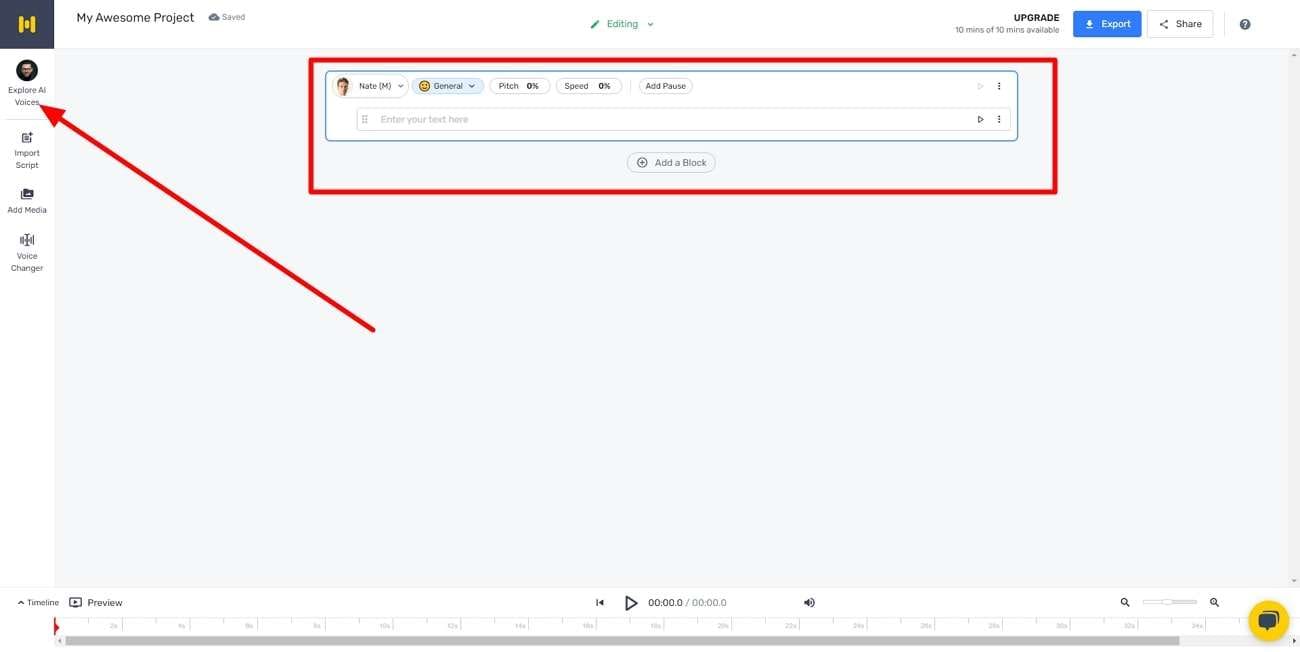
Step 3: Once satisfied with your project, click the “Export” button at the top right to save your audio.
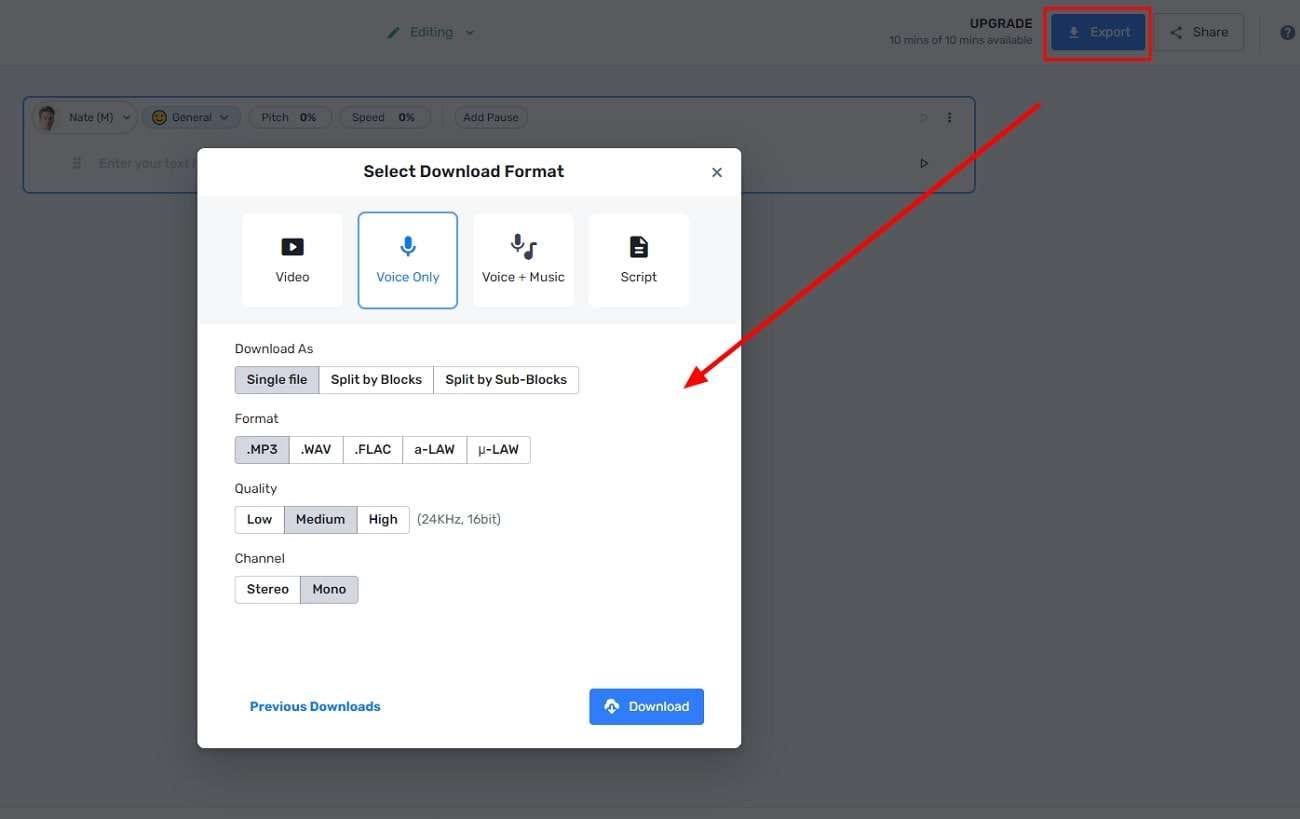
3. MicMonster
MicMonster is another top-rated tool that canconvert text to speech for free . With a straightforward interface, the website offers several voice options. Be it for e-learning or generating audiobooks, you can use MicMonster for all purposes.
The tool comes with an advanced editor that is relatively simple to use. You can also preview your full audio on MicMonster before downloading it. Select a voice from its growing library and convert it into natural-sounding speech using MicMonster.
Key Features
- On MicMonster, you can select a specific portion of your script and assign it to a voiceover of your choice. This way, you can generate multiple voices in the same audio file.
- You can fine-tune the audio’s rate, pitch, emphasis, and pauses. As a result, you can make your audio sound more natural.
- MicMonster allows users to customize pronunciations of certain words. This feature ensures that names, acronyms, and other important information get delivered without any trouble.
Steps To Generate Speech From Text Using MicMonster
Step 1: You can begin the conversion process by going to MicMonster. You can type in your text from the main interface in the text input field.
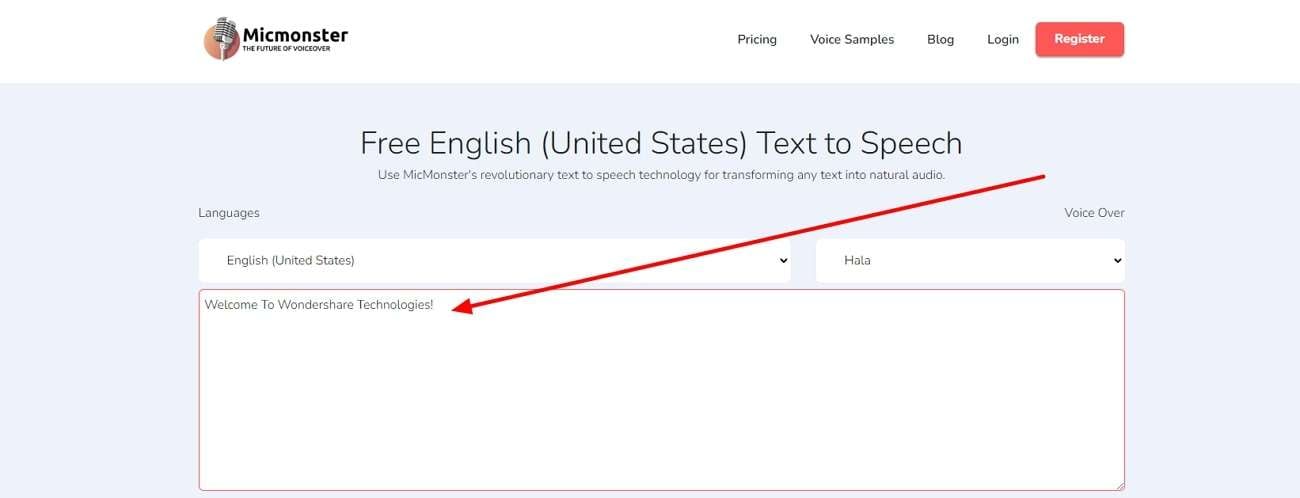
Step 2: From the top toolbar, you can select a language of your choice. In each language, MicMonster offers multiple voiceovers that you can choose.
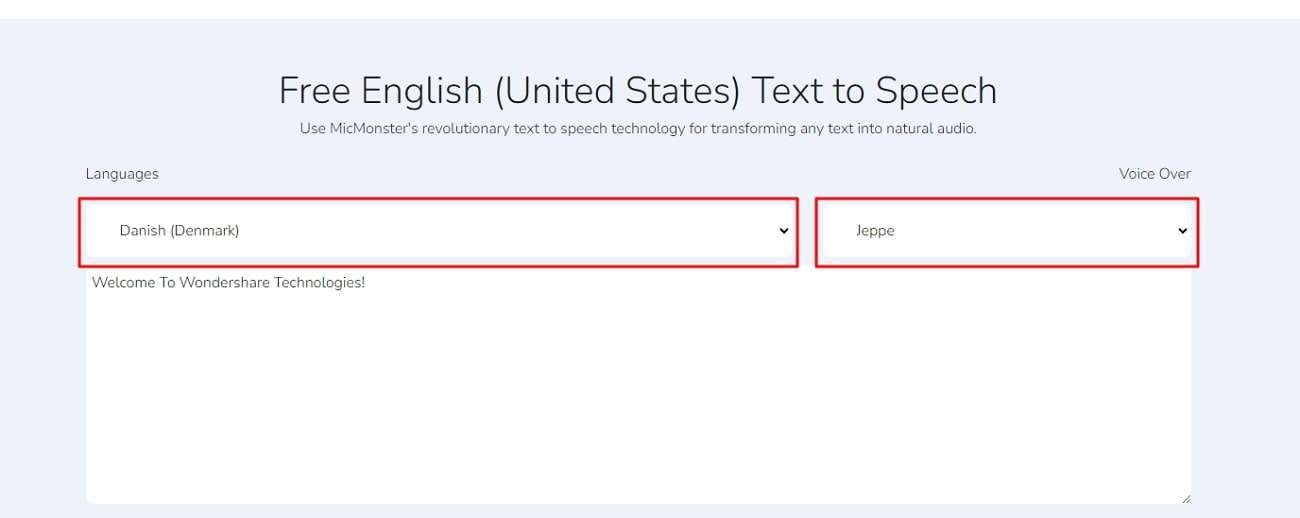
Step 3: Once everything is done, click “Generate” toturn your text into speech .
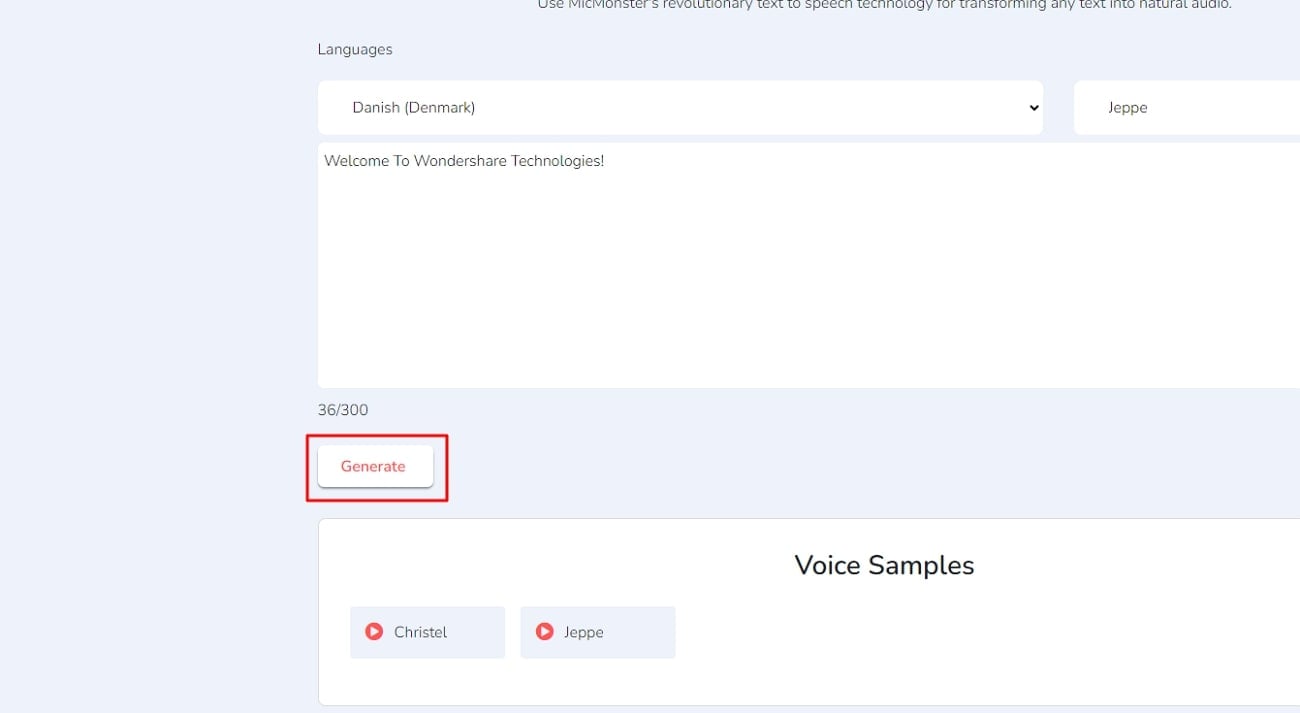
4. SpeechGen.io
If you want a cheap tool that caneasily generate audio from text , SpeechGen.io offers the perfect solution. Being a web-based tool, it is easily accessible to everyone. Its AI technology offers powerful text-to-speech conversions in no time.
SpeechGen.io offers a wide range of languages and voices. Its realistic voice generator abilities can help you produce content for all purposes. You can use SpeechGen.io for quick and easy text-to-audio conversions.
Key Features
- You can save the output audio file in multiple formats. Some examples include MP3, WAV, and OGG.
- io is compatible with many popular software, including Adobe Premier and After Effects. This feature is helpful if you want to refine your content further using professional editing programs.
- You can add your tracks to your cloud history on SpeechGen.io. You can also add audio files to your favorite list in one click.
Steps To Generate Speech Through Text Using SpeechGen.io
Step 1: Go to SpeechGen.io and type your text in the required field.
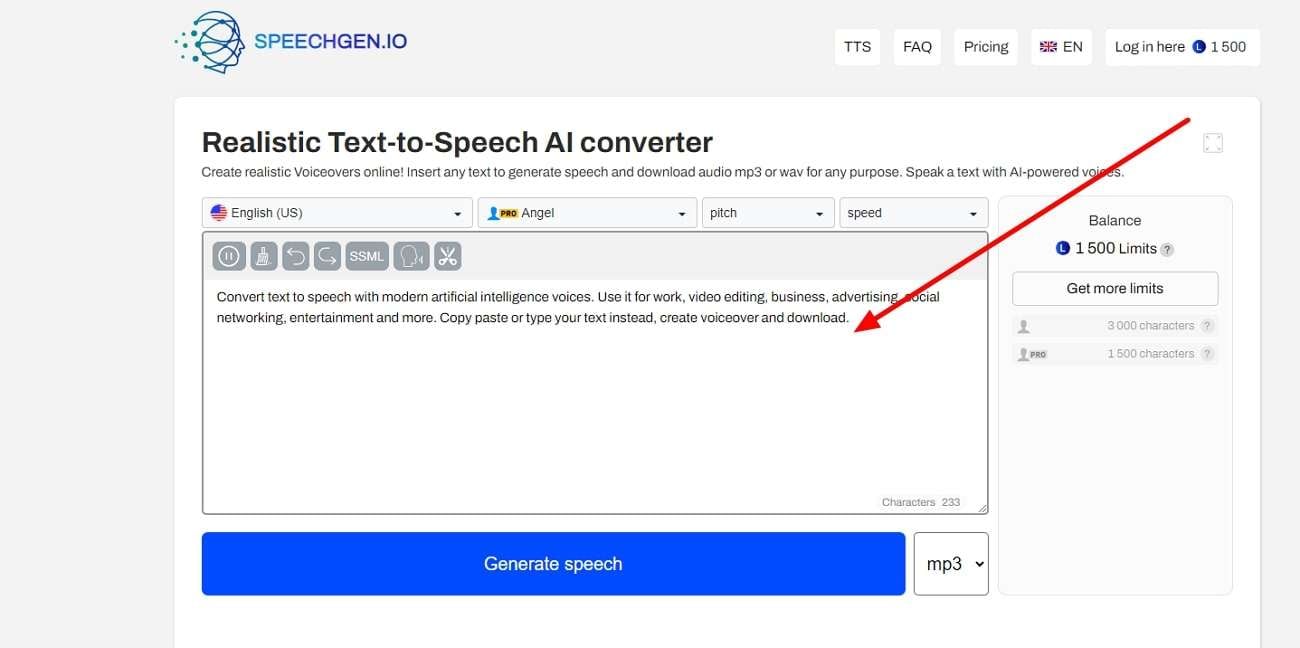
Step 2: Next, choose your language and AI voice. You can also select the pitch and speed of the audio. Once done, tap on “Generate speech.”
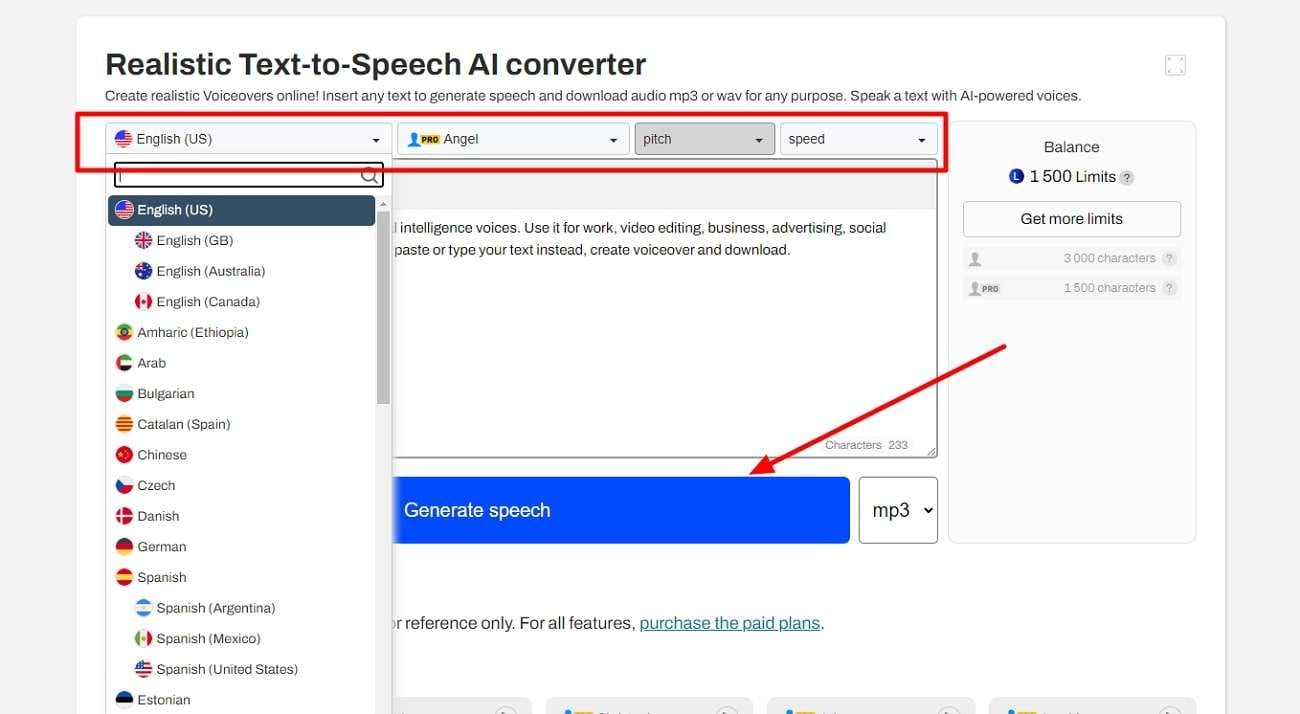
Step 3: You can then save your output file in a format of your choice.
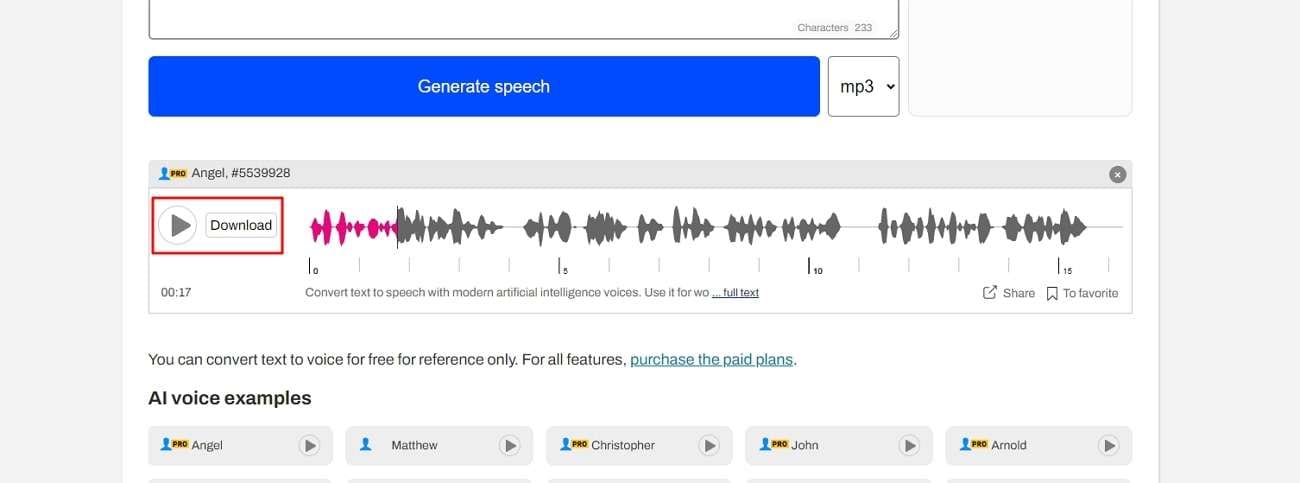
5. Listen2It
Listen2It is a remarkable AI tool that can generate realistic audio outputs from text. With more than 900 AI voices, the tool offers studio-level editing features. You can tweak all the audio aspects according to your liking.
Listen2It offers a friendly interface for all users. The tool can produce top-quality results in no time. You can use it for all purposes, from podcasts to educational and marketing content. Make use of Listen2It to generate vibrant voices and tones with remarkable ease.
Key Features
- Listen2It offers over 900 voices in more than 145 languages from across the globe. You can thus create diverse and inclusive content.
- You can add background audio to your tracks. This way, you can add a natural and realistic touch to the content.
- The tool also allows users to build custom AI characters. You can save specific audio settings for each character you build.
Steps To Use Listen2It Perfectly For Creating Speech From Text
Step 1: Go to Listen2It and tap the “Start” button. Once you reach the studio, click “Create Audio”.

Step 2: In the next window, you can type your text in the field. From the toolbar at the top, you can customize the language, voice, and other aspects of the audio.

Step 3: Afterward, click the “Download” button at the top-right corner to save your output file.
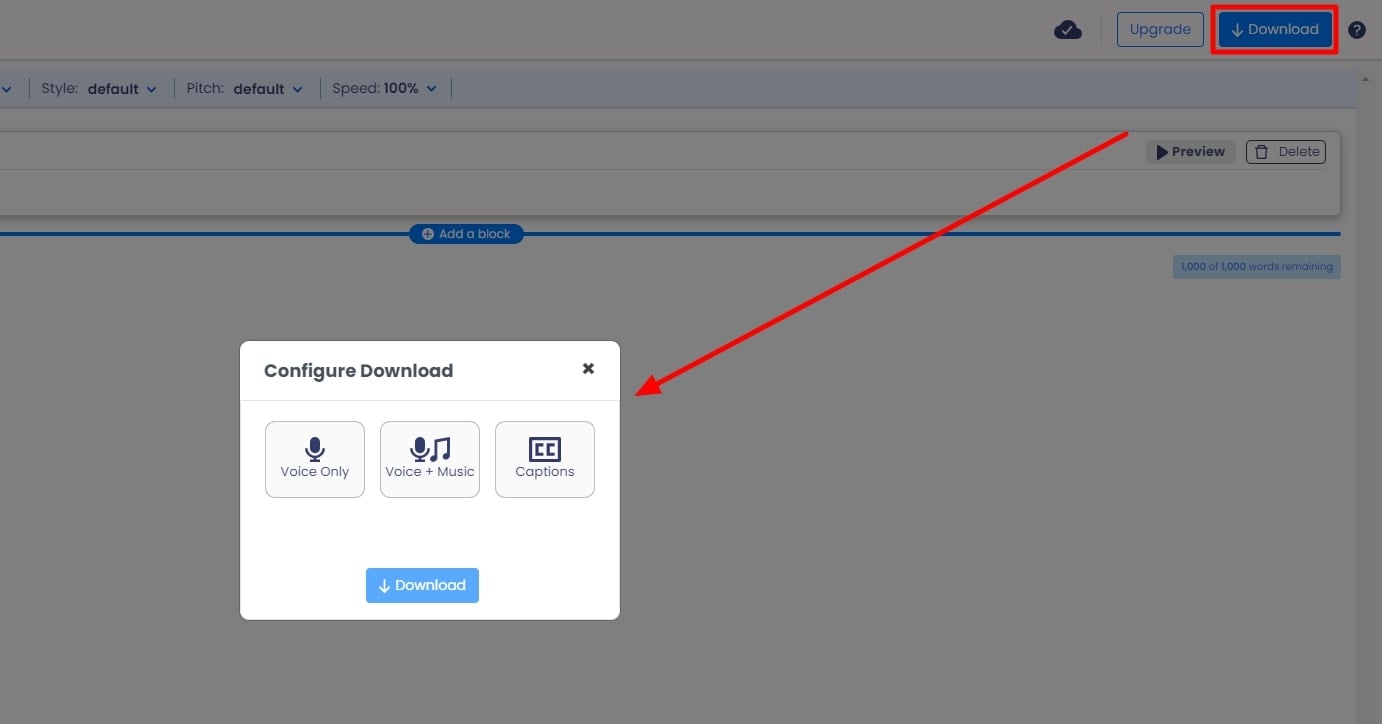
Conclusion
Text-to-speech converters are quickly taking over the world. Byconverting text to voice , you can increase the accessibility of your content. The converter tools mentioned above are a great way for effective communication and engagement with users. With increased demand, harnessing their powers for various aspects of everyday business is vital.
AI Video Translator | Online
AI Video Translator
It can be challenging and expensive for content creators to create a single video in multiple languages. To overcome this problem, Virbo has an innovative AI Video Translator feature that you can also use online.
02 Perform the Video Translation
04 Download the Translated Video
Step 1. Choose the Video Translate Feature
From the dashboard of Wondershare Virbo Online , choose the “Video Translator” feature under the “More AI Tools” section.
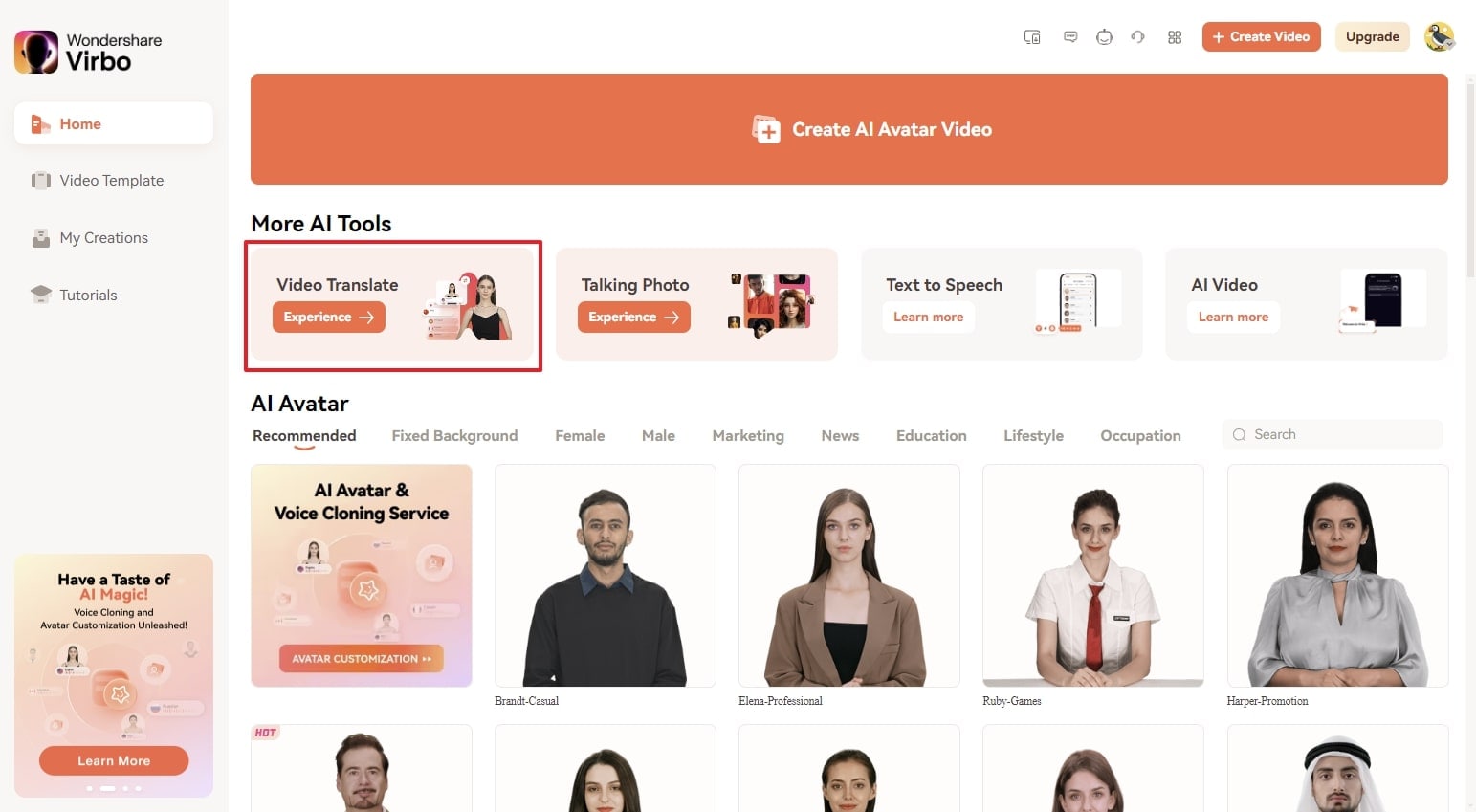
Choose Video Translator
Step 2. Perform the Video Translation
- To upload the video file for translation, press the “Click to upload video“ button, or you can use the drag-and-drop feature.
- Specify the “Original Video Language” and the “Target Language” and enable the required “Advanced Settings,” which are Lip-Sync, Subtitles, and Proofread Video Script.
- Finally, click the “Translate this video” button to change your video voice in the target language.
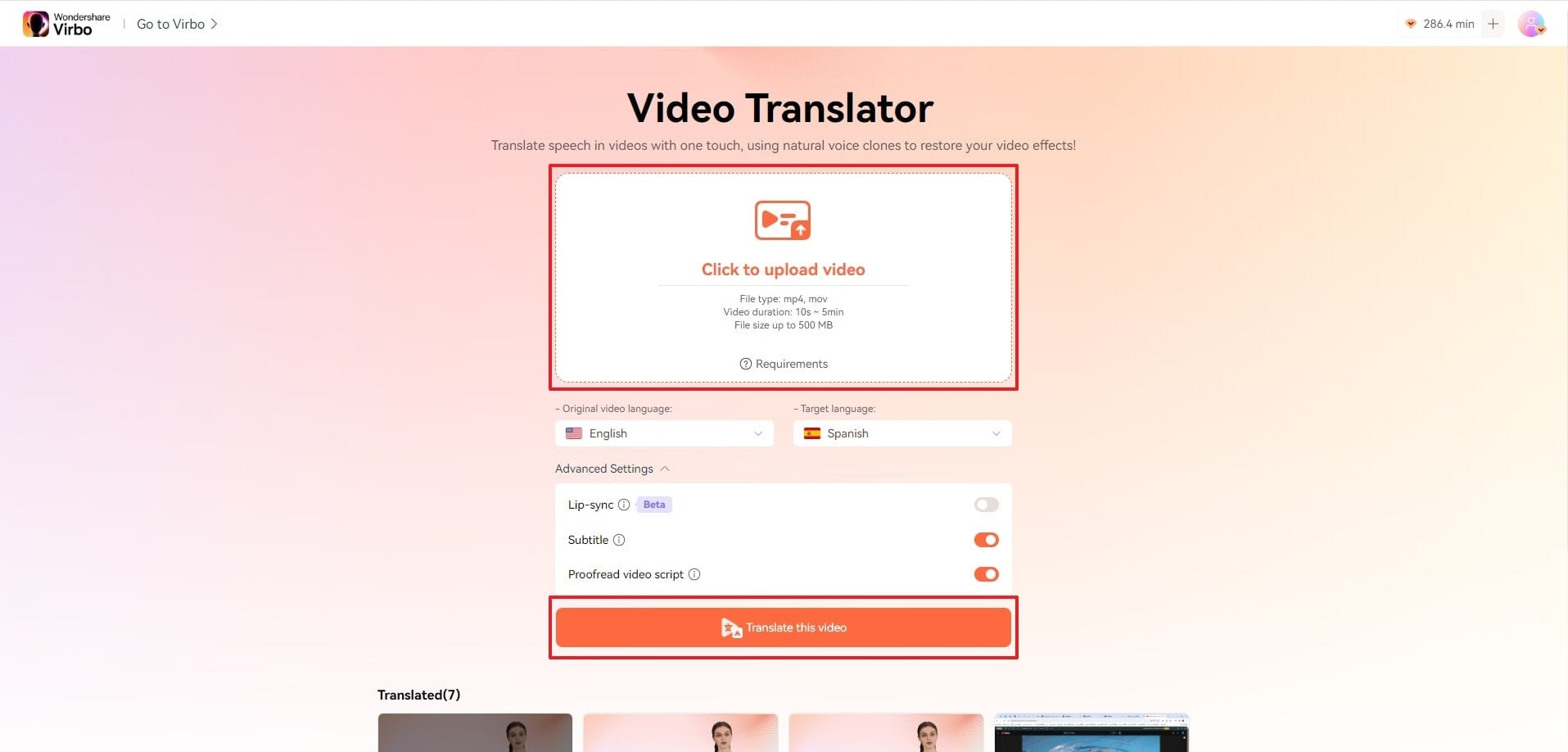
Perform Video Translation
Step 3. Proofread the Video Script
Proofread the translated video script to avoid any mistakes in the video. You can also export the subtitles file by tapping the “Download SRT” button. And then, click “Translate Video“
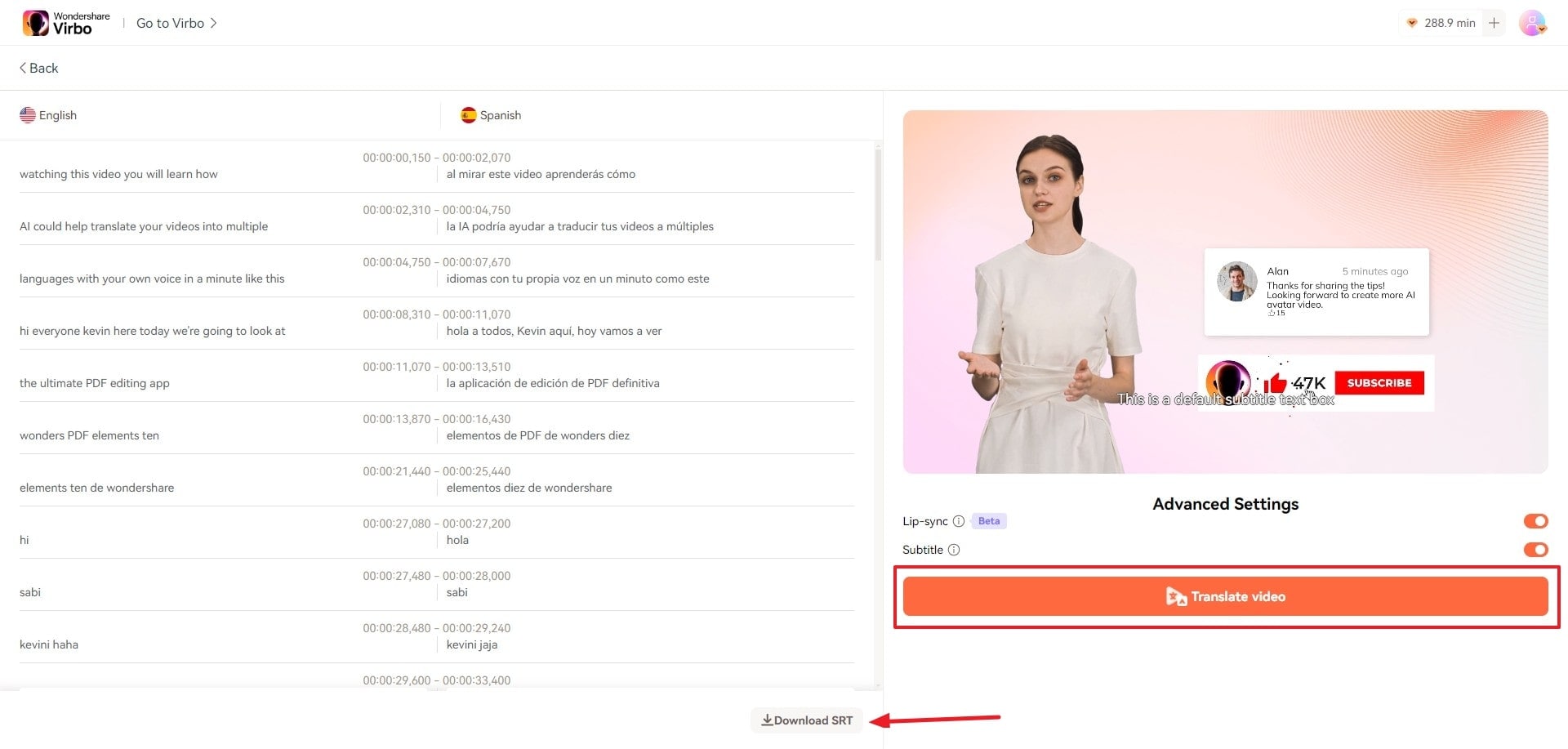
Proofread Script
Step 4. Proofread the Video Script
Preview the final version of the translated video and press the “Download Video” button to get it exported to your device.
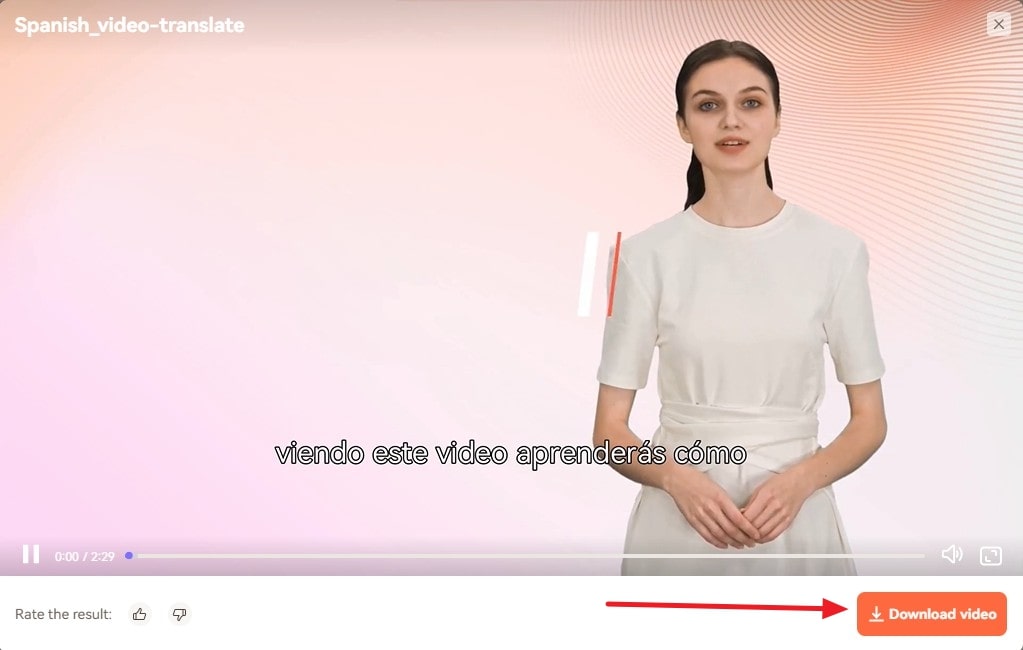
Download Video
FAQs about Video Translator
1Can I edit and export auto-generated subtitles?
Of course! You have the flexibility to modify and customize the generated subtitles to suit your preferences, and once done, you can seamlessly export the edited subtitle file.
2Is there a fee for using the Video Translator feature?
The Video Translator feature follows the Virbo subscription plan. This means that unsubscribed users can export a multilingual video of up to 2 minutes for free within 512MB storage space. For more information, please refer to the Virbo Subscription Plan>
3How accurate is the translation output?
The translation accuracy delivered by the Video Translator feature is remarkably high, thanks to the empowering capabilities of AI technology. The system utilizes advanced algorithms and machine learning to ensure precise and contextually relevant translations, enhancing the overall quality of the translated content.
02 Perform the Video Translation
04 Download the Translated Video
Step 1. Choose the Video Translate Feature
From the dashboard of Wondershare Virbo Online , choose the “Video Translator” feature under the “More AI Tools” section.

Choose Video Translator
Step 2. Perform the Video Translation
- To upload the video file for translation, press the “Click to upload video“ button, or you can use the drag-and-drop feature.
- Specify the “Original Video Language” and the “Target Language” and enable the required “Advanced Settings,” which are Lip-Sync, Subtitles, and Proofread Video Script.
- Finally, click the “Translate this video” button to change your video voice in the target language.

Perform Video Translation
Step 3. Proofread the Video Script
Proofread the translated video script to avoid any mistakes in the video. You can also export the subtitles file by tapping the “Download SRT” button. And then, click “Translate Video“

Proofread Script
Step 4. Proofread the Video Script
Preview the final version of the translated video and press the “Download Video” button to get it exported to your device.

Download Video
FAQs about Video Translator
1Can I edit and export auto-generated subtitles?
Of course! You have the flexibility to modify and customize the generated subtitles to suit your preferences, and once done, you can seamlessly export the edited subtitle file.
2Is there a fee for using the Video Translator feature?
The Video Translator feature follows the Virbo subscription plan. This means that unsubscribed users can export a multilingual video of up to 2 minutes for free within 512MB storage space. For more information, please refer to the Virbo Subscription Plan>
3How accurate is the translation output?
The translation accuracy delivered by the Video Translator feature is remarkably high, thanks to the empowering capabilities of AI technology. The system utilizes advanced algorithms and machine learning to ensure precise and contextually relevant translations, enhancing the overall quality of the translated content.
What Is an AI Tool?
Part 1: What is an AI Tool?
An AI tool refers to software or systems that leverage artificial intelligence algorithms and techniques to perform specific tasks or address complex problems. These tools aim to replicate human intelligence by analyzing vast amounts of data, identifying patterns, and generating predictions or recommendations.
Part 2: How does an AI Tool Work?
AI tools operate by utilizing various techniques such as machine learning, deep learning, natural language processing, and computer vision. They are trained on extensive datasets to learn patterns and make accurate predictions or classifications. Through algorithms, AI tools process and analyze data, identify trends, and generate valuable insights. Depending on the task at hand, AI tools can be trained to recognize images, comprehend speech, translate languages, detect anomalies, or automate repetitive tasks.
Part 3: What are the Widely Used AI Video Tools?
Several AI video tools have gained significant popularity across industries. Here are some widely used ones:
Video Analytics Platforms
These platforms, such as IBM Watson Media and NVIDIA Metropolis, employ AI algorithms to analyze video content. They can detect objects, recognize faces, track movements, and extract valuable information from video footage.
Video Editing and Enhancement Tools
AI-powered video editing tools like Adobe Premiere Pro, Virbo and Final Cut Pro X utilize machine learning algorithms to automate video editing tasks. They can enhance video quality, remove unwanted elements, and apply visual effects more efficiently.
Video Recommendation Systems
Platforms like YouTube and Netflix leverage AI to provide personalized video recommendations to users. These systems analyze user preferences, viewing history, and other factors to suggest relevant videos, enhancing the user experience.
Video Content Moderation Tools
AI tools such as Google Cloud Video Intelligence and Microsoft Azure Video Indexer assist in content moderation by automatically identifying and flagging inappropriate or offensive content in videos.
Part 4: What do we Need to Consider While Using AI Tools?
While utilizing AI tools, several factors should be taken into consideration:
Data Quality
AI tools heavily rely on high-quality and relevant data for training and accurate predictions. Ensuring the data used is clean, unbiased, and representative is crucial for the effectiveness of AI applications.
Ethical Considerations
AI tools should be developed and used ethically, considering factors such as privacy, fairness, and transparency. It is essential to avoid biases and ensure that the AI system does not discriminate against any individual or group.
Integration and Scalability
AI tools should seamlessly integrate with existing systems and have the capability to scale with increasing data volumes. Compatibility with other tools and frameworks is vital for smooth integration and efficient workflow.
Continuous Monitoring and Improvement
AI tools require regular monitoring and improvement to maintain accuracy and effectiveness. Regular updates and retraining of models may be necessary to adapt to evolving data patterns and enhance performance.
Conclusion
AI tools are software or systems that leverage artificial intelligence techniques to perform tasks and address complex problems. They find applications in various industries and can significantly enhance decision-making processes. However, careful consideration of data quality, ethical considerations, integration capabilities, and continuous monitoring is essential while utilizing AI tools in order to maximize their benefits.
Part 1: What is an AI Tool?
An AI tool refers to software or systems that leverage artificial intelligence algorithms and techniques to perform specific tasks or address complex problems. These tools aim to replicate human intelligence by analyzing vast amounts of data, identifying patterns, and generating predictions or recommendations.
Part 2: How does an AI Tool Work?
AI tools operate by utilizing various techniques such as machine learning, deep learning, natural language processing, and computer vision. They are trained on extensive datasets to learn patterns and make accurate predictions or classifications. Through algorithms, AI tools process and analyze data, identify trends, and generate valuable insights. Depending on the task at hand, AI tools can be trained to recognize images, comprehend speech, translate languages, detect anomalies, or automate repetitive tasks.
Part 3: What are the Widely Used AI Video Tools?
Several AI video tools have gained significant popularity across industries. Here are some widely used ones:
Video Analytics Platforms
These platforms, such as IBM Watson Media and NVIDIA Metropolis, employ AI algorithms to analyze video content. They can detect objects, recognize faces, track movements, and extract valuable information from video footage.
Video Editing and Enhancement Tools
AI-powered video editing tools like Adobe Premiere Pro, Virbo and Final Cut Pro X utilize machine learning algorithms to automate video editing tasks. They can enhance video quality, remove unwanted elements, and apply visual effects more efficiently.
Video Recommendation Systems
Platforms like YouTube and Netflix leverage AI to provide personalized video recommendations to users. These systems analyze user preferences, viewing history, and other factors to suggest relevant videos, enhancing the user experience.
Video Content Moderation Tools
AI tools such as Google Cloud Video Intelligence and Microsoft Azure Video Indexer assist in content moderation by automatically identifying and flagging inappropriate or offensive content in videos.
Part 4: What do we Need to Consider While Using AI Tools?
While utilizing AI tools, several factors should be taken into consideration:
Data Quality
AI tools heavily rely on high-quality and relevant data for training and accurate predictions. Ensuring the data used is clean, unbiased, and representative is crucial for the effectiveness of AI applications.
Ethical Considerations
AI tools should be developed and used ethically, considering factors such as privacy, fairness, and transparency. It is essential to avoid biases and ensure that the AI system does not discriminate against any individual or group.
Integration and Scalability
AI tools should seamlessly integrate with existing systems and have the capability to scale with increasing data volumes. Compatibility with other tools and frameworks is vital for smooth integration and efficient workflow.
Continuous Monitoring and Improvement
AI tools require regular monitoring and improvement to maintain accuracy and effectiveness. Regular updates and retraining of models may be necessary to adapt to evolving data patterns and enhance performance.
Conclusion
AI tools are software or systems that leverage artificial intelligence techniques to perform tasks and address complex problems. They find applications in various industries and can significantly enhance decision-making processes. However, careful consideration of data quality, ethical considerations, integration capabilities, and continuous monitoring is essential while utilizing AI tools in order to maximize their benefits.
What Is an AI Headshot Generator? | Wondershare Virbo Glossary
Part 1. What is an AI headshot generator?
An AI headshot generator is a software or application that utilizes artificial intelligence (AI) to create realistic and high-quality headshot images of individuals. These generators use deep learning techniques to produce lifelike portraits from scratch, often employing convolutional neural networks (CNNs) and generative adversarial networks (GANs).
Users typically provide input to the AI headshot generator, such as specifying certain attributes or characteristics they want in the generated image, like age, gender, ethnicity, facial expression, and more. The AI then processes this input and generates a corresponding headshot that matches the desired criteria.
These generators can be used for various purposes, including creating profile pictures, avatars, character images for games or storytelling, and even for artistic or creative projects. It’s worth noting that while these generators can produce impressive results, they might sometimes unintentionally perpetuate certain biases present in the training data, which is an important consideration when using such tools.
Part 2. Can AI-created headshots be used in professional occasion?
Certainly! AI-generated headshots have become increasingly sophisticated and can be employed in various professional settings. Here are some points to consider when using AI-created headshots for professional occasions:
1. Quality and Realism
Before utilizing AI-generated headshots in a professional context, ensuring that the images’ quality and realism meet your standards is crucial. The headshots should look natural and professional, without any apparent distortions or artifacts.
2. Consistency
AI-generated headshots can offer a consistent visual aesthetic across your team’s profiles or marketing materials. It can help establish a cohesive brand identity and create a polished impression.
3. Time and Cost Efficiency
Generating headshots with AI can be quicker and more cost-effective than scheduling and conducting photoshoots for every individual. It is particularly useful when working with large teams or for time-sensitive projects
4. Personal Data Privacy
When using AI to generate headshots, you don’t need to collect personal photographs of your team members. It can help address privacy concerns arising from collecting and using private photos.
5. Ethical Considerations
Considering any ethical implications of using AI-generated content is essential. Transparency is critical—let your audience know if the images are AI-generated, not actual photographs.
6. Diversity and Inclusion
AI-generated headshots should reflect diversity and inclusivity. Ensure that your tool has been trained on a diverse dataset to avoid unintentional biases in gender, ethnicity, age, etc.
7. Customization
Some AI headshot generators allow customization, such as adjusting facial expressions, hairstyles, and other features. This can help tailor the generated images to match your brand’s unique style.
8. Legal Considerations
Be aware of copyright or licensing issues related to the AI-generated images. Ensure you have the right to use and distribute the photos for your intended purposes.
Ultimately, the decision to use AI-generated headshots in professional settings depends on your specific needs and the industry in which you operate. As AI technology improves, these generated images will likely become even more convincing and versatile for various applications.
Part 1. What is an AI headshot generator?
An AI headshot generator is a software or application that utilizes artificial intelligence (AI) to create realistic and high-quality headshot images of individuals. These generators use deep learning techniques to produce lifelike portraits from scratch, often employing convolutional neural networks (CNNs) and generative adversarial networks (GANs).
Users typically provide input to the AI headshot generator, such as specifying certain attributes or characteristics they want in the generated image, like age, gender, ethnicity, facial expression, and more. The AI then processes this input and generates a corresponding headshot that matches the desired criteria.
These generators can be used for various purposes, including creating profile pictures, avatars, character images for games or storytelling, and even for artistic or creative projects. It’s worth noting that while these generators can produce impressive results, they might sometimes unintentionally perpetuate certain biases present in the training data, which is an important consideration when using such tools.
Part 2. Can AI-created headshots be used in professional occasion?
Certainly! AI-generated headshots have become increasingly sophisticated and can be employed in various professional settings. Here are some points to consider when using AI-created headshots for professional occasions:
1. Quality and Realism
Before utilizing AI-generated headshots in a professional context, ensuring that the images’ quality and realism meet your standards is crucial. The headshots should look natural and professional, without any apparent distortions or artifacts.
2. Consistency
AI-generated headshots can offer a consistent visual aesthetic across your team’s profiles or marketing materials. It can help establish a cohesive brand identity and create a polished impression.
3. Time and Cost Efficiency
Generating headshots with AI can be quicker and more cost-effective than scheduling and conducting photoshoots for every individual. It is particularly useful when working with large teams or for time-sensitive projects
4. Personal Data Privacy
When using AI to generate headshots, you don’t need to collect personal photographs of your team members. It can help address privacy concerns arising from collecting and using private photos.
5. Ethical Considerations
Considering any ethical implications of using AI-generated content is essential. Transparency is critical—let your audience know if the images are AI-generated, not actual photographs.
6. Diversity and Inclusion
AI-generated headshots should reflect diversity and inclusivity. Ensure that your tool has been trained on a diverse dataset to avoid unintentional biases in gender, ethnicity, age, etc.
7. Customization
Some AI headshot generators allow customization, such as adjusting facial expressions, hairstyles, and other features. This can help tailor the generated images to match your brand’s unique style.
8. Legal Considerations
Be aware of copyright or licensing issues related to the AI-generated images. Ensure you have the right to use and distribute the photos for your intended purposes.
Ultimately, the decision to use AI-generated headshots in professional settings depends on your specific needs and the industry in which you operate. As AI technology improves, these generated images will likely become even more convincing and versatile for various applications.
Also read:
- [New] In 2024, How to Take Screenshots on A Chromebook
- [New] Transforming SRT Files Into Text A Speedy Expertise Guide
- [Updated] Cultivate Creativity 20+ Inspiring YouTube Concepts
- 2024 Approved Unveiling the Methodology for Quality PS3 Game Screenings
- Cost-Effective Performance of the TP-Link RE200 Ac750 Range Extender - An In-Depth Evaluation
- Mastering Digital Engagement Across Leading Sites: Insights Into Facebook, Twitter, Instagram & YouTube
- Revolutionary Computer Setup Comes With Its Own Full-Sized Internal Coffee Station
- Unbeatable Deal: Get the MSI Aegis R2 (RTX nVIDIA 4070 Super & Core I7-14700KF) Below $1,600 - Top Tier Custom Built Gaming PC
- Unveiling Technology Secrets: Tom's Compreh
- Title: What Are AI Tools? | Wondershare Virbo Glossary
- Author: Sam
- Created at : 2024-10-06 18:29:25
- Updated at : 2024-10-08 16:53:13
- Link: https://ai-voice-clone.techidaily.com/what-are-ai-tools-wondershare-virbo-glossary/
- License: This work is licensed under CC BY-NC-SA 4.0.